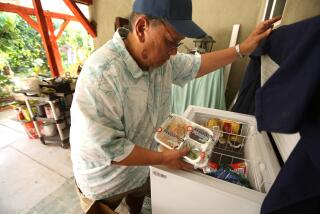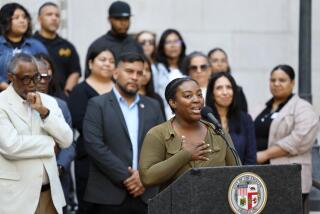Should Workers Share the Poverty They Fight?
- Share via
SACRAMENTO — Once a month, Whitney Easton leaves his AmeriCorps VISTA national service job running a Sacramento teen program to stand in line at a local food stamp outlet.
The $9,300 or so that Volunteers in Service to America pays him and his colleagues annually to work on anti-poverty projects in low-income communities is just not enough to make ends meet, Easton said.
Since VISTA members are prohibited from working second jobs, Easton and many members of what is often described as a domestic Peace Corps rely on savings and parental aid, work off the books or apply for food stamps.
Pending legislation would change that, allowing them to hold additional jobs. The proposal has raised debate about the nature and effectiveness of the 37-year-old federal program, which employs 7,000 people nationwide.
Easton runs a “Weed and Feed” program, “weeding” out crime and “feeding in” new opportunities for low-income teens, such as starting a community garden in Sacramento.
He understands why VISTA workers are expected to live at the economic levels of the communities they serve and why they are not allowed to do anything that might lure them away from their 24-hour-a-day responsibilities.
“When we’re working in the community, it’ll give us better judgment,” Easton said.
But he supports the proposed change to allow part-time jobs for those who think they must supplement VISTA incomes. Time spent applying and waiting for food stamps takes the volunteers away from their tasks anyway, he said.
The 24-year-old, originally from Providence, R.I., has simple tastes and is not afraid of hard work. A Northeastern University graduate, Easton furnished his Sacramento studio apartment with items that other people had discarded--he calls it “trash picking.” He can’t remember when he last bought new clothing. If he and his friends go out, they hunt for bars without cover charges.
VISTA workers “tend to find great deals,” said Easton, who is to finish his yearlong stint in the program at the end of August.
He had some savings and paid off most of his debts before moving. Easton also concedes that he bent the rules by working occasional odd jobs--a few hours on weekends landscaping or doing light carpentry--but said he would not take a second job that required regular commitment.
By January, his savings had dwindled. But VISTA officials told him he could apply for food stamps. Before he could pick up his $130 worth of monthly food coupons, he was so broke that he went to a food bank for groceries to hold him over.
Despite the apparent hardship, Easton loves his VISTA experience. He believes in the philosophy of 24-7 immersion, which dates back to the early days of the program, started by President Lyndon B. Johnson as part of his War on Poverty.
But the proposed Citizen Service Act of 2002 offers to reform different federal service organizations, including AmeriCorps, which encompasses VISTA. In phases, the bill would limit the workweek of VISTA workers to 40 hours instead of the open-ended commitment and allow second jobs and part-time education.
This will fundamentally change the program, said Mimi Mager, board member of Friends of VISTA, an alumni association that opposes the change.
With a 24-7 commitment, “you are totally involved; you are totally engaged in the community. [Volunteers] would understand and know the community in a deeper way, and never just be sitting there punching a clock,” she said.
But the proposed change simply recognizes that VISTA life should allow time for other activities, said Les Lenkowsky, chief executive of the Corporation for National Service, which manages AmeriCorps and USA FreedomCorps, the volunteer program President Bush introduced in his State of the Union speech. Lenkowsky supports the proposed changes.
“Nobody does 24-7,” he said. “That’s always been one of those mythical qualities” of the program.
The other 43,000 members of AmeriCorps, including those working on environmental, health and literacy programs, already can work second jobs. “We just want one standard rule with as much flexibility as possible,” Lenkowsky said.
Most full-time AmeriCorps volunteers receive about $9,300 a year, an amount based on the federal poverty level. VISTA workers in areas where the cost of living is higher get paid slightly more.
In addition, all AmeriCorps volunteers can defer payment on student loans and receive health insurance and child care allowances. When they complete their yearlong commitments, they also get educational awards of $4,725 apiece that can be applied toward outstanding debts or future schooling. VISTA workers have the option of receiving stipends of $1,200 instead of educational awards.
Keeping stipends small weeds out people who aren’t serious about service, Lenkowsky said.
“We do feel members in AmeriCorps are to be expected to make sacrifices,” he said.
Having the financial freedom to volunteer at such a low wage is a luxury, said Pittsburgh native Claire Lobes, a 25-year-old VISTA worker.
She works in microeconomic development at JobStarts, Inc. in South-Central Los Angeles. She graduated from Georgetown University and got a master’s degree in political theory at the London School of Economics.
Rather than being allowed second jobs, Lobes thinks VISTA workers should be paid 200% of the federal poverty income level. “If you have nothing to go back to, you could end up in a bad financial condition,” Lobes said. “If you’re financially vulnerable, you can’t afford to do VISTA.”
To pay for her apartment in Brentwood, Lobes relies on her savings from her previous job developing strategies for CEOs. Living at the federal poverty level, “you can’t eat. It’s just not sustainable,” Lobes said.
VISTA members tend to be young--47% are younger than 30, and 31% are 20 to 24--and some come into the program with credit card debt or car payments in addition to their expenses for the year. Some rack up additional debts.
Ashlie Mildfelt, 24, ended up owing hundreds of dollars to creditors after finishing her VISTA project reorganizing a teen anti-discrimination program at the L.A. Gay & Lesbian Center in Los Angeles in January. The Texas native believes that prohibiting VISTA workers from taking second jobs is unfair.
“My argument was working poor people have second jobs. They have three to four jobs,” she said.
Shelter during the year for Chris Hunter, a 26-year-old VISTA worker in Portland, Ore., took the form of his father’s couch, friends’ houses and brief stints house-sitting.
“Even though I am living like a member of the ‘hidden homeless,’ I have support I can fall back on. There’s definitely family assistance for food--showing up at mom’s house at 6,” he said.
He had planned to tutor children on the side but dropped the idea because of VISTA regulations.
Lobes said many VISTA participants gain the experience needed to launch careers at nonprofits. “It’s sort of irresponsible to have people take on debt to go into a low-paying field,” Lobes said. “It’s a program designed to alleviate poverty in the United States, yet it forces its members to live in poverty.”
But Lobes believes she has learned a lot from the program. “It’s fundamentally reshaped the way I see the world,” she said.
More to Read
Sign up for Essential California
The most important California stories and recommendations in your inbox every morning.
You may occasionally receive promotional content from the Los Angeles Times.










